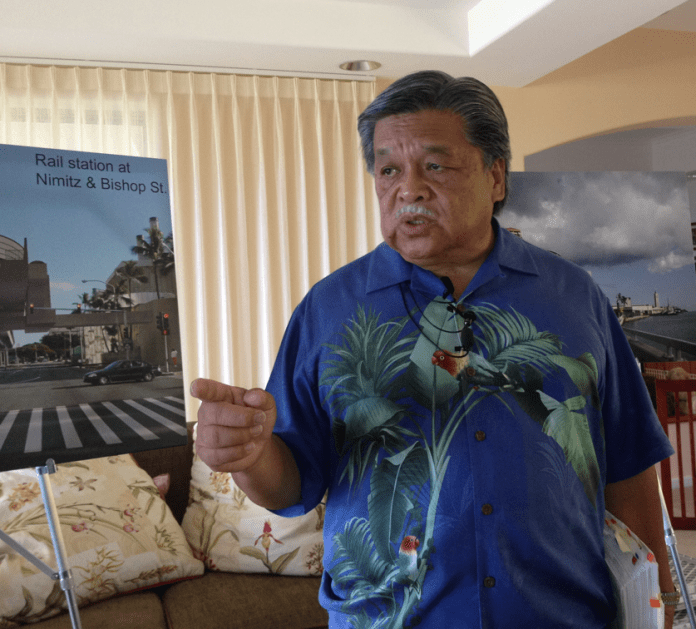

BY BEN CAYETANO – Traffic congestion on Oahu is getting worse – but the proposed rail system would not solve the problem. The City and the Federal Transit Administration admit this in their final EIS where they write: “traffic congestion will be worse in the future with rail than what it is today without rail.
Their EIS shows 21 percent more cars on the road if we build rail and 23 percent more if we do not. Is this what the Star-Advertiser calls a traffic “solution”?
The City estimated rail would cost $5.2 billion, but state and federal studies predict the cost could be over $7 billion. Why spend billions on rail when we can expect that traffic congestion in the future would get worse with or without rail? This is why no city remotely comparable to Honolulu in size has built or plans to build elevated, steel on steel heavy rail system.
Enhance Honolulu’s Bus System
Honolulu’s bus system is rated the best in the nation. My plan begins by enhancing rather than dismantling it as the city is now doing as part of its plan for rail.
I would plan and implement an enhanced version of the bus rapid transit plan contained in the 2003 Final Environmental Impact Statement I signed as Governor and that the Federal Transit Administration approved in 2003. Full details of the Regional from the Ewa Plain and Mililani areas to Town are in this Final EIS.
The city paid Parsons Brinkerhoff more than $10 million for the 2003 study, which concluded that Bus Rapid Transit (BRT) was superior to rail as it would generate higher ridership at roughly one-fifth the cost ($1.04 billion).
The In-Town phase originally planned to run on dedicated lanes on Kapiolani and Ala Moana but was criticized for taking car lanes on those two heavily congested boulevards. We are mindful of the criticism and will review the In-town phase with a focus on using King and Beretania streets instead.
It should be noted that BRT will be able to run to UH Mānoa and also Waikīkī whereas rail could not since the tourist industry is solidly opposed to heavy rail running on an elevated concrete structure through Waikiki.
Within the first year, I would increase the number of express and direct-route buses, and make better use of the zipper lanes and freeway-shoulder-use program that were initiated during my second term as governor. I will significantly increase the number of point-to-point routes from Kapolei, Mililani, Wahiawa, Waianae and Windward Oahu, to downtown, Ala Moana, Waikiki and the UH-Manoa campus.
We would work with the Governor in the removal of major bottlenecks (such as the Middle Street merge), and to expedite them I would urge the Governor to form a state-city joint venture with the city sharing the costs of construction. We would implement measures that would improve island-wide mobility such as state-of-the-art computerized traffic signals that have been promised by the last four administrations but with little result.
Finally, it doesn’t cost much to retrofit buses with Wi-Fi and other amenities. The new buses are sleeker, more fuel efficient and environmentally friendly than rail. Moreover, BRT buses will have more seats than rail cars and the presence of a bus driver provides security not available on the driverless rail cars. One can only wonder whether parents will risk putting their children alone on the rail cars or how young women would feel riding the train alone at night.
Fast Solutions, Flexible Routes Serving the Entire Island
We can introduce BRT faster than rail because we would not be starting from scratch. Given its higher-than-rail ridership projections, lower-than-rail costs and readiness to deploy, I believe federal assistance would be available to help finance the system.
We can implement BRT solutions relatively quickly with little disruption to the environment or to businesses during construction. Unlike rail, which is fixed in place, BRT routes can be adjusted and new routes implemented. Furthermore, they do not block view planes, nor do they damage historical sites or unearth burial grounds.
And virtually all of the jobs created by my BRT plan and the upgrading of the City’s sewer and water systems and the repaving of the roads will be jobs our local workers can do.
According to HART’S executive director, Daniel Grabauskas, the cost of the rail system as originally planned (with spurs to UH-Manoa and Waikiki) would be $9.03 billion!Nonetheless, my opponents mindlessly oblivious to costs, advocate extending rail to Manoa, North Shore, Hawaii Kai and Kailua also.
When I listen to my opponents visions of spending billions on a non-solution to the traffic problem I wonder if they have amnesia about raw sewage flowing down the Ala Wai Canal and onto our beaches, the building moratoriums in major areas of our city, and the third ranked worse roads in the nation.
The upgrading of the city’s basic infrastructure is woefully behind schedule. A significant infusion of funds is needed to get the systems up to speed. I have a plan to do this – my opponent does not.

Rally Against Rail today 11am Honolulu Hale!
Comments are closed.